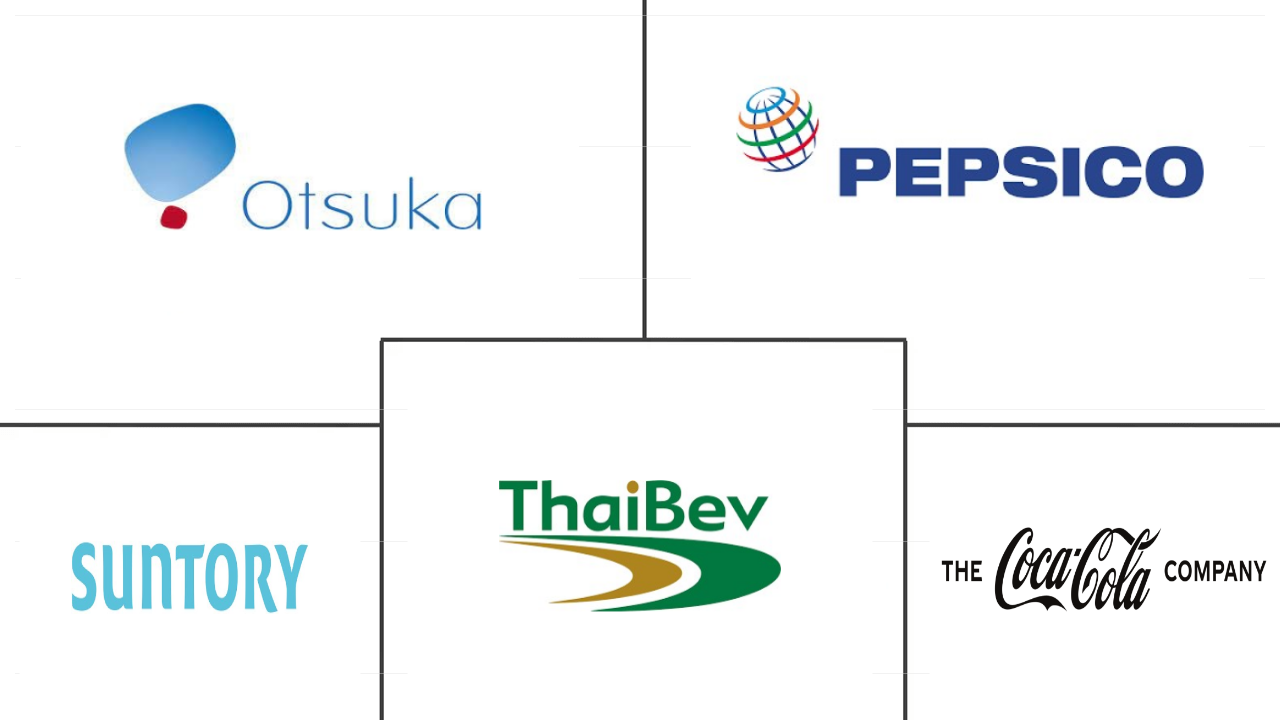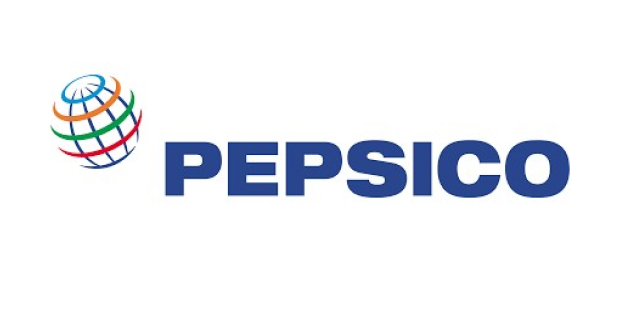Market Size of sports drinks Industry
|
|
Study Period | 2018 - 2030 |
|
|
Market Size (2024) | USD 26.48 Billion |
|
|
Market Size (2030) | USD 36.14 Billion |
|
|
Largest Share by Soft Drink Type | Isotonic |
|
|
CAGR (2024 - 2030) | 5.32 % |
|
|
Largest Share by Region | North America |
Major Players |
||

|
||
|
*Disclaimer: Major Players sorted in no particular order |
Sports Drinks Market Analysis
The Sports Drinks Market size is estimated at 26.48 billion USD in 2024, and is expected to reach 36.14 billion USD by 2030, growing at a CAGR of 5.32% during the forecast period (2024-2030).
26.48 Billion
Market Size in 2024 (USD)
36.14 Billion
Market Size in 2030 (USD)
4.16 %
CAGR (2018-2023)
5.32 %
CAGR (2024-2030)
Largest Segment by Soft Drink Type
55.09 %
value share, Isotonic, 2023
Isotonic beverages extend beyond mere hydration by offering functional advantages through the addition of vitamins and minerals to cater to health requirements, contributing to the growth of the segments.
Largest Region
52.77 %
value share, North America, 2023
Increasing per capita consumption, owing to longstanding sports culture majorly driven by United States and Canada countries is making up North America share in the market.
Fastest-growing segment by Soft Drink Type
7.58 %
Projected CAGR, Hypertonic, 2024-2030
Hypertonic drinks are becoming popular amongst young people as these drinks with ample carbohydrates are more effective in delivering energy for high intensity activities.
Fastest-growing region
8.90 %
Projected CAGR, Africa, 2024-2030
The increasing international brands availability with significant growth in sports and athletics, resulting in a demand for high nutritional value drinks is enhancing growth.
Leading Market Player
42.68 %
market share, PepsiCo, Inc., Inc.

PepsiCo. Inc. leverages endorsements from prominent athletes and celebrities, as well as strategic promotional campaigns at festivals and events, enabling it to capture a significant market share.
Consumers indulging in intense physical activities is supporting the market growth
- The sales value of sports drinks across the world registered a growth rate of 11.1% in 2023 compared to 2021. Sports drinks are especially beneficial for athletes and actively help them to remain hydrated before and after exercise. It improves an athlete’s performance and is rich in carbohydrates, minerals, and electrolytes.
- Isotonic sports drinks hold the major segment in the market. In the study period, it has registered a growth rate of 15.3% by value in 2023 compared to the year 2020. Health and wellness trends have played a pivotal role in propelling the sports drinks market's growth. Consumers are increasingly drawn to isotonic sports drinks due to their perceived health benefits. Isotonic drinks are also absorbed quickly by the body, which is important for athletes who need to replenish their fluids and electrolytes quickly. Isotonic sports drinks offer a diverse range of flavors to cater to varying taste preferences. Brands such as Gatorade, Powerade, Body Armor, and Prime offer isotonic sports drinks in a wide range of flavors and different packaging sizes.
- Hypertonic drinks are anticipated to register the fastest CAGR of 8.48% by value from 2024 to 2030. The consumption of hypertonic drinks is common among athletes who engage in intense exercise, such as crossfit, weightlifting, and high-intensity interval training (HIIT). Sporting events, including marathons, triathlons, and extreme endurance challenges, are anticipated to increase between 2024 and 2030, and hypertonic drinks are provided as part of their race support; hence, they are anticipated to boost market growth.
The global sales of sports drinks are being propelled by a growing emphasis on health and fitness
- From 2018 to 2023, the global sports drinks market witnessed a robust 22.37% growth in value. This surge can be attributed to a rising global interest in sports and fitness, fueled by concerns over obesity and diabetes. Responding to this trend, sports drink manufacturers have been innovating, and tailoring their offerings to meet consumer demands. For example, in March 2021, GoodSport Nutrition, a startup based in Rosemont, unveiled a sports drink that is 97% dairy-based. Similarly, in August 2022, Limca, a brand under The Coca-Cola Company, introduced "Limca Sportz," its inaugural sports drink variant, in India. Limca Sportz, a glucose and electrolyte-based beverage, caters to the needs of sports enthusiasts for rehydration.
- In 2023, North America emerged as the dominant player in the global sports drinks market. The region's leadership can be attributed to a surge in its population actively participating in sports and physical activities. Additionally, a growing emphasis on health and fitness, especially among the younger demographic, is pushing market players to focus on nutritional and low-calorie offerings. Notably, the United States stands out as a key market, with a notable uptick in athletic pursuits. In 2022, a significant 60% of athletes in the US reported consuming sports drinks primarily for rehydration.
- Africa is poised to be the fastest-growing market for sports drinks, with a projected value CAGR of 12.34%. This surge in demand can be attributed to the region's burgeoning sporting landscape, including the rising popularity of leagues like football and cricket. Additionally, there has been a notable increase in health clubs and fitness centers in recent years, further fueling the demand for sports drinks in the region.
Sports Drinks Industry Segmentation
Electrolyte-Enhanced Water, Hypertonic, Hypotonic, Isotonic, Protein-based Sport Drinks are covered as segments by Soft Drink Type. Aseptic packages, Metal Can, PET Bottles are covered as segments by Packaging Type. Convenience Stores, Online Retail, Specialty Stores, Supermarket/Hypermarket, Others are covered as segments by Sub Distribution Channel. Africa, Asia-Pacific, Europe, Middle East, North America, South America are covered as segments by Region.
- The sales value of sports drinks across the world registered a growth rate of 11.1% in 2023 compared to 2021. Sports drinks are especially beneficial for athletes and actively help them to remain hydrated before and after exercise. It improves an athlete’s performance and is rich in carbohydrates, minerals, and electrolytes.
- Isotonic sports drinks hold the major segment in the market. In the study period, it has registered a growth rate of 15.3% by value in 2023 compared to the year 2020. Health and wellness trends have played a pivotal role in propelling the sports drinks market's growth. Consumers are increasingly drawn to isotonic sports drinks due to their perceived health benefits. Isotonic drinks are also absorbed quickly by the body, which is important for athletes who need to replenish their fluids and electrolytes quickly. Isotonic sports drinks offer a diverse range of flavors to cater to varying taste preferences. Brands such as Gatorade, Powerade, Body Armor, and Prime offer isotonic sports drinks in a wide range of flavors and different packaging sizes.
- Hypertonic drinks are anticipated to register the fastest CAGR of 8.48% by value from 2024 to 2030. The consumption of hypertonic drinks is common among athletes who engage in intense exercise, such as crossfit, weightlifting, and high-intensity interval training (HIIT). Sporting events, including marathons, triathlons, and extreme endurance challenges, are anticipated to increase between 2024 and 2030, and hypertonic drinks are provided as part of their race support; hence, they are anticipated to boost market growth.
| Soft Drink Type | |
| Electrolyte-Enhanced Water | |
| Hypertonic | |
| Hypotonic | |
| Isotonic | |
| Protein-based Sport Drinks |
| Packaging Type | |
| Aseptic packages | |
| Metal Can | |
| PET Bottles |
| Sub Distribution Channel | |
| Convenience Stores | |
| Online Retail | |
| Specialty Stores | |
| Supermarket/Hypermarket | |
| Others |
| Region | ||||||||||||
| ||||||||||||
| ||||||||||||
| ||||||||||||
| ||||||||||||
| ||||||||||||
|
Sports Drinks Market Size Summary
The sports drinks market is experiencing significant growth, driven by increasing consumer interest in health and wellness. This sector is particularly beneficial for athletes, as these beverages help maintain hydration and enhance performance through their rich content of carbohydrates, minerals, and electrolytes. Isotonic sports drinks dominate the market due to their rapid absorption and diverse flavor offerings, appealing to a wide range of consumers. The market is also witnessing innovation, with new products like GoodSport Nutrition's dairy-based drink and Coca-Cola's Limca Sportz catering to specific consumer needs. The rise in sporting events and fitness activities globally is further propelling market expansion, with hypertonic drinks gaining popularity among those engaged in intense physical activities.
Regionally, North America leads the market, supported by a strong culture of sports and fitness, particularly among younger populations. The United States is a key player, with a significant number of athletes relying on sports drinks for rehydration. Meanwhile, Africa is emerging as the fastest-growing market, fueled by the popularity of sports leagues and the proliferation of fitness centers. In the Asia-Pacific region, there is a growing demand for premium sports drinks, with consumers willing to pay more for enhanced flavors and health benefits. The market is fairly consolidated, with major companies like PepsiCo, The Coca-Cola Company, and Otsuka Holdings Co Ltd dominating the landscape. Recent partnerships and product launches, such as Pepsi Gatorade's collaboration in Saudi Arabia and Limca Sportz's new variant in India, highlight the ongoing strategic developments within the industry.
Sports Drinks Market Size - Table of Contents
-
1. MARKET SEGMENTATION (includes market size in Value in USD and Volume, Forecasts up to 2030 and analysis of growth prospects)
-
1.1 Soft Drink Type
-
1.1.1 Electrolyte-Enhanced Water
-
1.1.2 Hypertonic
-
1.1.3 Hypotonic
-
1.1.4 Isotonic
-
1.1.5 Protein-based Sport Drinks
-
-
1.2 Packaging Type
-
1.2.1 Aseptic packages
-
1.2.2 Metal Can
-
1.2.3 PET Bottles
-
-
1.3 Sub Distribution Channel
-
1.3.1 Convenience Stores
-
1.3.2 Online Retail
-
1.3.3 Specialty Stores
-
1.3.4 Supermarket/Hypermarket
-
1.3.5 Others
-
-
1.4 Region
-
1.4.1 Africa
-
1.4.1.1 Egypt
-
1.4.1.2 Nigeria
-
1.4.1.3 South Africa
-
1.4.1.4 Rest of Africa
-
-
1.4.2 Asia-Pacific
-
1.4.2.1 Australia
-
1.4.2.2 China
-
1.4.2.3 India
-
1.4.2.4 Indonesia
-
1.4.2.5 Japan
-
1.4.2.6 Malaysia
-
1.4.2.7 South Korea
-
1.4.2.8 Thailand
-
1.4.2.9 Vietnam
-
1.4.2.10 Rest of Asia-Pacific
-
-
1.4.3 Europe
-
1.4.3.1 Belgium
-
1.4.3.2 France
-
1.4.3.3 Germany
-
1.4.3.4 Italy
-
1.4.3.5 Netherlands
-
1.4.3.6 Russia
-
1.4.3.7 Spain
-
1.4.3.8 Turkey
-
1.4.3.9 United Kingdom
-
1.4.3.10 Rest of Europe
-
-
1.4.4 Middle East
-
1.4.4.1 Qatar
-
1.4.4.2 Saudi Arabia
-
1.4.4.3 United Arab Emirates
-
1.4.4.4 Rest of Middle East
-
-
1.4.5 North America
-
1.4.5.1 Canada
-
1.4.5.2 Mexico
-
1.4.5.3 United States
-
1.4.5.4 Rest of North America
-
-
1.4.6 South America
-
1.4.6.1 Argentina
-
1.4.6.2 Brazil
-
1.4.6.3 Rest of South America
-
-
-
Sports Drinks Market Size FAQs
How big is the Global Sports Drinks Market?
The Global Sports Drinks Market size is expected to reach USD 26.48 billion in 2024 and grow at a CAGR of 5.32% to reach USD 36.14 billion by 2030.
What is the current Global Sports Drinks Market size?
In 2024, the Global Sports Drinks Market size is expected to reach USD 26.48 billion.

